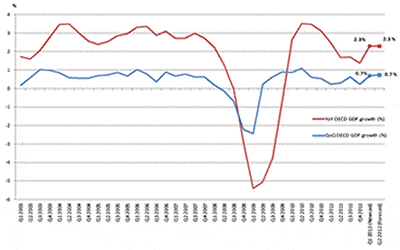“Focusing on one economic indicator is a guaranteed way to lose money,” a senior bank economist told me recently, when I asked him what weight should be given to the myriad statistical data released being dissected for signs of economic growth, or – failing that – life.
That may be so. But as asset owners look for reasons to invest, CEOs search for excuses to identify strategic acquisitions and bankers scour spread sheets for evidence to support revenue projections, GDP growth figures will get their fair share of attention. The UK’s Office for National Statistics will issue its first reading of British GDP growth in Q1 2012 on Wednesday (25 April), potentially confirming a double-dip recession following Q4 2011’s 0.3% contraction. While inflation, employment and industrial production all give vital clues as to the nature of economic activity – denoting at this stage of the economic cycle how far we have yet to travel along the road to recovery – GDP growth figures remain the economic equivalent of taking the patient’s pulse. As such, they are often the basis of that elusive but critical indicator, confidence. Higher GDP growth figures can make the difference betweenhaving the confidence to take a stake in a new venture in a growth sector, rather than sticking with tried and tested investment strategies. Insufficient levels of confidence in the overall economy generate only a self-fulfilling spiral of stagnation and inactivity.
If GDP growth is so totemic, then there may be some good news for the recovery of developed economies from the aftermath of the global financial crisis, regardless of the UK’s figures on Wednesday. At the end of last week, SWIFT released its latest monthly index, which implied 2.3% GDP growth across OECD (Organisation for Economic Co-operation and Development) member countries in Q1 2012 compared to Q1 2011, an increase from the 2.0% GDP growth level predicted by SWIFT in March. Moreover, it confirmed the same continued rate of progress (i.e. 2.3% annualised GDP growth) in Q2 2012. Launched in Q3 2011, the SWIFT index uses an independently validated methodology (by the Centre for Operations Research and Econometrics, an interdisciplinary research institute specialising in econometrics, economic theory, game theory and operations research) to predict growth levels based on month-on-month changes in traffic levels (specifically, MT103 payment messages) across its global financial messaging network. The figure below shows quarterly and annual GDP growth rates for the OECD countries from 2003.

SWIFT calls its reading of Q1 2011 GDP growth a ‘nowcast’ rather than a forecast, using a term borrowed by economists from weather forecasters that refers to the prediction of the present or the very recent past, on grounds that much of the value of the SWIFT Index lies in its use of immediately available monthly data, i.e. MT103 volumes, thereby allowing policy-makers and other readers of economic runes to adjust to changes in economic activity in a more timely manner. As boosts to economic confidence go, the SWIFT Index should prove more immediate then most.